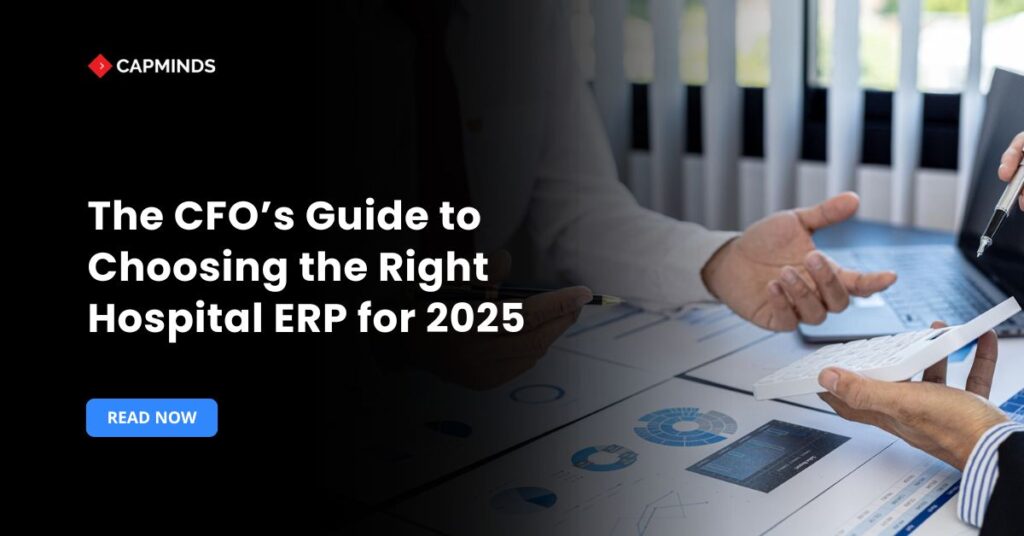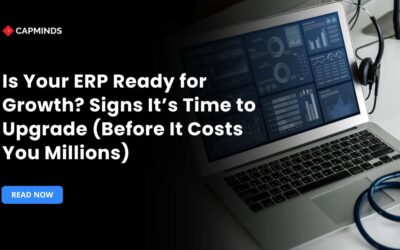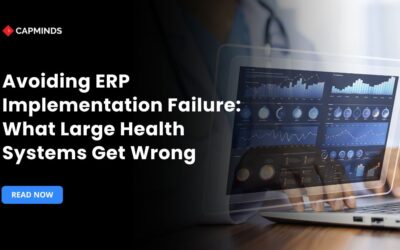The CFO’s Guide to Choosing the Right Hospital ERP for 2025
Hospital CFOs today face unprecedented pressure to cut costs, improve patient outcomes, and comply with regulations – all while modernizing their finance and operations systems. The answer lies in a cloud-based ERP that unifies financials with clinical and operational workflows.
Chartis Group estimates that “more than 50% of the U.S. News & World Report Best Hospitals have made a move to cloud ERP”, signaling a major industry shift. Similarly, Deloitte reports that roughly 90% of healthcare executives expect digital technologies to “accelerate in 2025”.
These data highlight that leading health systems are adopting cloud ERP not just for finance, but as a strategic platform integrating supply chain, HR, analytics, and patient care workflows under one umbrella.
- For CFOs, the implications are clear: cloud ERP is now a core enabler of efficiency and insight.
- Modern cloud systems eliminate many legacy silos and “technical debt.”
- A study notes that hospitals sticking with old on-premise systems risk “paying interest on technical debt” rather than realizing new efficiencies.
- By moving to a unified cloud platform, finance leaders can automate labor-intensive processes and finally get real-time visibility into costs and operations across the enterprise.
- One recent survey by GHX found that nearly 70% of hospitals expect to adopt cloud-based supply chain solutions by 2026, citing improved efficiency, lower costs, and better decision-making as the top benefits.
- In practice, this means a cloud ERP can streamline purchasing, inventory, and billing so CFOs can control costs without compromising patient care.
Importantly, cloud ERP offers strategic agility. When built right, next-gen systems can “produce efficiency gains and lower costs across finance, supply chain, and human capital management”, ultimately reducing the hospital’s cost of care and improving workforce satisfaction. For example, a unified system can immediately flag areas of waste and empower data-driven budgeting.
In an era of shrinking margins and growing compliance demands, these gains directly contribute to ROI. A healthcare CIO survey confirms that maximizing ROI from technology buys is a top priority today. For CFOs, investing in cloud ERP is no different: success means defining clear performance targets and tracking them rigorously.
Related: The Comprehensive Role of ERP Systems in Healthcare
Core ERP Capabilities for Hospitals
A modern hospital ERP spans far more than finance. Best-practice systems now include broad operations modules and analytics that touch virtually every department. CFOs should look for these key capabilities:
1. Financial Management & Analytics
Comprehensive budgeting, general ledger, and financial close automation, all with built‑in analytics. Advanced ERP tools can automate month-end closing and provide drill-down dashboards on cash flow, profitability by service line, and departmental expenses.
Real-time financial reporting (dashboards and alerts) helps CFOs manage cash more tightly and spot issues before they escalate. (Study shows notes that defining targets like labor productivity savings and financial management efficiencies up front is critical to realizing ERP ROI.)
2. Supply Chain & Procurement
Digital, AI-driven inventory and procurement. The latest ERPs support automated purchasing workflows (e.g., e-procurement, contract compliance) and real-time inventory tracking. A study highlights “supply chain digitization, a clinically integrated supply chain, and real-time inventory management” as a key cloud ERP advancement.
Cloud platforms can forecast demand using usage data, minimize stockouts, and enforce negotiated pricing – all of which directly lower costs. As the GHX study found, cloud supply chains “enhance decision-making, improve efficiency and agility, reduce costs, [and] improve data security and privacy”.
3. Human Capital & Workforce
End-to-end employee management and workforce analytics. Leading cloud ERP systems include modules for HR, payroll, and labor planning. They offer self-service portals so staff can manage schedules, benefits, and time-off requests online, and they use analytics to track recruitment and turnover.
The study specifically mentions “mobile workforce management, employee self-service, behavioral analytics, and talent science” as new ERP functionalities. For CFOs, better workforce data (like acuity-based staffing models and overtime costs) means avoiding costly agency spend and reducing turnover.
4. Clinical Integration & Patient Experience
Connectivity with EHR and patient systems. While financial ERPs don’t replace clinical EHRs, they increasingly integrate with them. A modern ERP can centralize patient registration, scheduling, and billing data, giving a single source of truth. Study emphasizes that new ERP platforms are “enabling enterprise integration with health systems’ EHRs to achieve… a centralized information platform and single source of truth across the organization.”
This integration helps streamline the patient journey: for example, patient accounts and insurance verification can flow between clinical and financial systems, reducing billing errors and improving the patient’s experience. In the long run, having unified data supports initiatives like value-based care and price transparency.
5. Regulatory Compliance & Security
Built‑in compliance tools for healthcare standards. Cloud ERPs come with robust security and audit capabilities. They support encrypted data at rest and in transit, strict access controls, and detailed audit trails – essential for HIPAA and other regulations. Many solutions include automated reporting to simplify regulatory filings and make audits smoother.
- For CFOs, this means less risk of fines and more trust from patients and payers.
- As one healthcare IT expert advises, organizations should implement “multi-layered security protocols, including robust encryption, access controls, audit trails, and regular security assessments…to ensure HIPAA compliance,”.
6. Enterprise Analytics & BI
Real-time dashboards and predictive analytics. Unlike siloed legacy systems, cloud ERPs aggregate data from across the hospital. Finance leaders can have live dashboards showing key metrics (e.g., days cash on hand, expense-to-revenue ratios, supply costs per patient) updated daily or hourly.
- A study notes that new ERP technology provides “real-time analytics” and makes finance “smarter, faster, and leaner” by putting “actionable insights” at executives’ fingertips.
- With predictive analytics, CFOs can also model scenarios – for example, forecasting the financial impact of changes in case volume or payer mix – enabling more agile budgeting.
Together, these capabilities turn an ERP into a comprehensive platform for hospital operations, not just bookkeeping. With all data in one cloud system, finance and hospital leaders can collaborate on strategic initiatives (like supply chain collaboration with clinical teams or cross-departmental cost reduction), rather than wrestling with mismatched spreadsheets.
Related: ERPNext 101: The Ultimate Guide to Adopting ERPNext in USA Healthcare
Steps to Evaluate and Select the Right ERP
CFOs need a clear decision framework to navigate ERP choices. Here’s a step-by-step guide:
1. Define Strategic Objectives
Begin by articulating the business goals driving the ERP investment.
- What problems must it solve?
- Are you targeting efficiency gains, data transparency, new service lines, regulatory compliance, or all of the above?
- As Prosci advises, the CFO should lead a conversation about “What are the business reasons for implementing the change?
- What do you want to accomplish?”.
This alignment on objectives (e.g., reducing cost per case, improving cash flow, or enabling analytics-driven decisions) will focus the evaluation and help set ROI targets.
2. Assemble a Cross-Functional Team
Involve key stakeholders early. Apart from finance, include representatives from supply chain, IT, HR, compliance, and clinical operations. Broad involvement ensures the ERP requirements reflect everyone’s needs (for example, nursing schedulers and pharmacy will have valuable input on clinical integration and inventory tracking).
This also builds executive buy-in, which Study shows cites as critical: CFOs should work with the CIO and transformation leader to drive strategic investments.
3. Assess Current Processes
Map the existing end-to-end processes to identify pain points. Common issues include manual workarounds, fragmented data, and compliance gaps. Study warns that without a “future-state business process strategy,” organizations end up with limited or missing functionality.
CFOs should document the most important processes (e.g., procure-to-pay, order entry, record-to-report) and highlight where delays, errors, or high costs occur. This analysis will drive the list of required ERP features.
4. Develop Requirements and Prioritize
Based on objectives and process gaps, list out needed capabilities. Cover all broad areas: core finance (GL, AR/AP), supply chain, HCM, analytics, patient billing, compliance reporting, etc. Prioritize “must-have” versus “nice-to-have.” Also require the system must be cloud-based, scalable, and standards-compliant.
For each feature, define success metrics (for example, <5% uncollected patient accounts, or 25% fewer invoice approvals needed). A study emphasizing documenting benefit targets “like labor productivity savings, financial management efficiencies, and supply chain cost reductions”, so the ROI is measurable.
5. Evaluate and Score Solutions
With requirements in hand, review vendor offerings (through RFPs, demos, or proof-of-concepts). Score them not only on functionality but also on criteria that matter in healthcare: security (e.g., HITRUST certification), interoperability (FHIR support), scalability, and user adoption features.
Consider the total cost of ownership (TCO), including cloud subscription fees and integration costs. Engage clinicians and administrators in demonstrations to vet usability.
Pay special attention to vendors’ healthcare experience and support model – the CFO should ask about implementation time and partnerships, since a Study notes rapid-cycle (not multi-year) ERP projects are now the norm.
6. Build the Business Case
For shortlisted solutions, quantify the expected ROI. Include hard savings (like reduced FTE effort in AP, or lower supply spend from better contracting) and soft benefits (like improved compliance or faster decision-making).
A study advises using a “dashboard-driven approach” to track benefit realization during and after implementation. Also factor in risks and mitigation (e.g., data migration costs or temporary productivity dips). CFOs should ensure the case clearly shows the payback timeline and who owns each benefit.
7. Plan Change Management
Recognize that technology alone isn’t enough. Allocate resources for training, communication, and organizational readiness. Prosci’s research reminds us that “to get the full value from your investment, it pays to start with the end users”. Involve front-line staff early (for example, get sample workflows from nurses or procurement clerks) and prepare them for new ways of working.
According to a Study, disciplined change management (with strong communication plans and executive sponsorship) is crucial to avoid reverting to old habits. A smooth go-live schedule and support plan will make or break the project’s success.
8. Finalize and Implement
After selecting a system, define a rollout plan (big bang vs phased). CFOs should stay engaged during implementation, monitoring progress against the defined milestones. Use a project dashboard to track actual improvements in real time.
As the Study shows, notes, “periodic in-flight reviews” allow timely course corrections. Finally, once live, hold teams accountable to the KPIs set in step 6.
Strategic ROI and Value
By following this framework, CFOs can ensure that the chosen ERP delivers measurable value. When fully deployed, a cloud ERP can transform the finance function from a bottleneck to a business enabler. Automated workflows cut operating costs, while unified data improves forecasting accuracy. More efficient supply chain and workforce management directly expand margin, and richer analytics drive smarter capital allocation. Notably, the Study concludes that done well, ERP “will reduce the health system’s cost of care and improve workforce satisfaction and long-term growth,”– a direct line to the CFO’s bottom line and organizational objectives.
Hospitals that delay modernization will increasingly lag peers. As Study bluntly states, the question is “when, not if” to migrate to next-generation ERP. In 2025, CFOs should seize this moment. A strategic cloud ERP is more than an IT project – it is a platform for innovation, growth, and resilience. By aligning finance strategy with technology, CFOs can steer their organizations toward sustainable performance, ensuring resources are used efficiently and patients receive the highest quality care.
CapMinds ERP Solution for Hospitals
CapMinds ERP Solution empowers hospitals with a seamless, integrated approach to managing operations, finances, and patient care.
It streamlines workflows, automates key processes, and enhances overall efficiency.
- With advanced analytics, real-time reporting, and interoperability features, CapMinds ERP ensures data-driven decision-making and compliance with industry standards.
- Our tailored ERP solutions are designed to meet the unique needs of healthcare providers, offering scalability, security, and cost-effectiveness for long-term success.
CapMinds ERP prioritizes seamless integration with existing systems, ensuring smooth adoption and minimal disruption to your hospital.
Get the best-in-class ERP solution from CapMinds, featuring intuitive dashboards, automated billing, supply chain management, financial planning, and much more, all customized to fit your needs.
“Optimize your healthcare practice with the most reliable and efficient ERP solution from CapMinds.”




